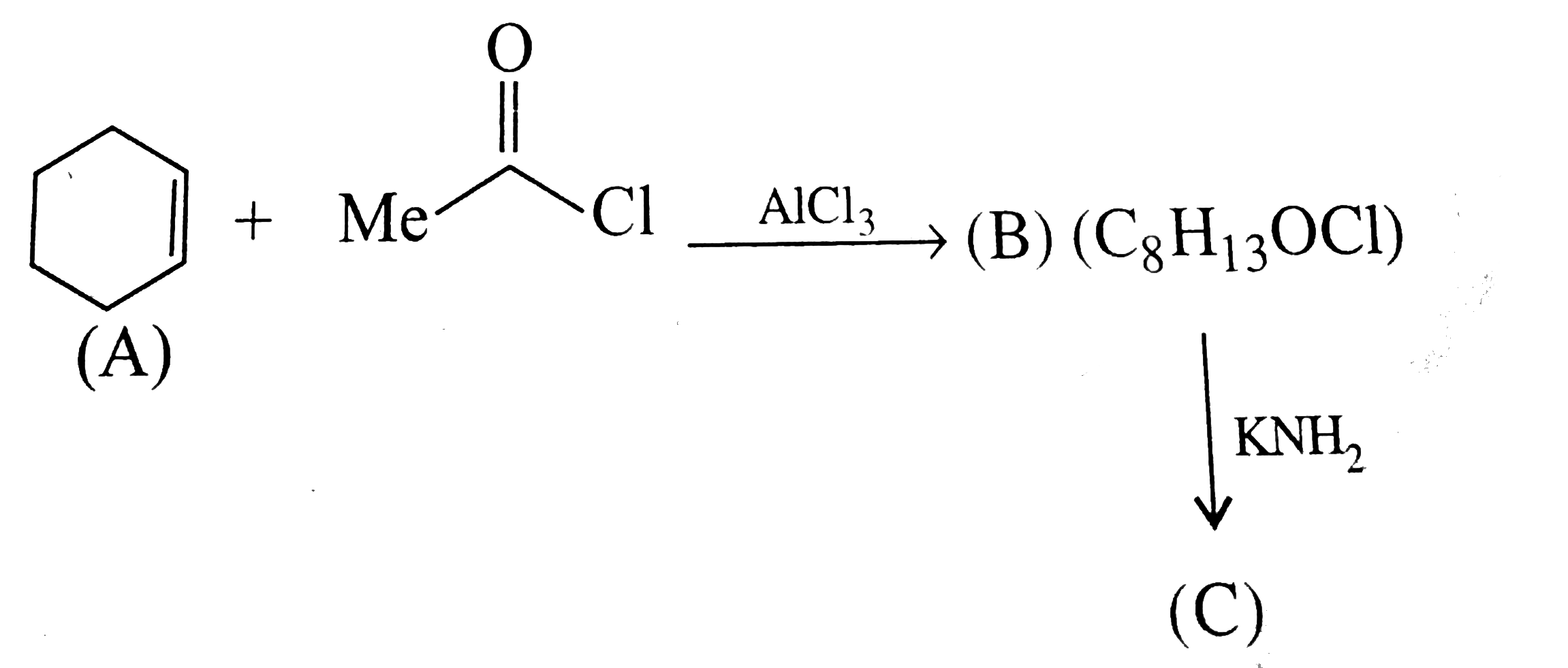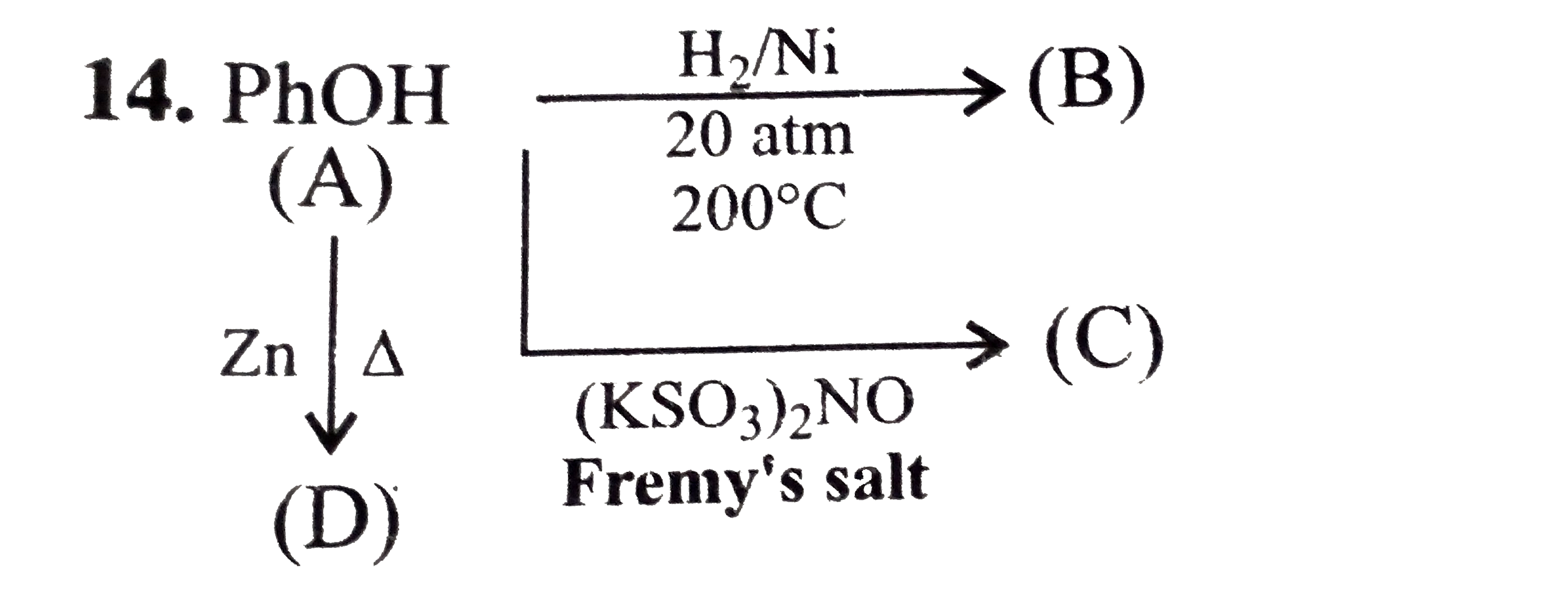The compound (A) in the previous question is further hydrolysed in dilute acidic medium to give compounds (B) and (C). The compounds (B) and (C) are :
PhNH2 and PhCH=O
PhCH2NH2 and PhCH=O
PhNH2 and PhCH2CH=O
PhCH2NH2 and PhCH2CH=O.
The correct Answer is:C
To solve the question regarding the hydrolysis of compound (A) in a dilute acidic medium to yield compounds (B) and (C), we can follow these steps:
1. Identify Compound (A):
- From the previous context, compound (A) is identified as a compound with a phenyl group and a double bond, specifically, it can be represented as phenyl-CH=CH2 (styrene).
2. Understanding Hydrolysis:
- Hydrolysis in a dilute acidic medium typically involves the addition of water (H2O) across the double bond. The acidic medium (H3O+) facilitates the reaction by providing protons.
3. Breaking the Double Bond:
- The double bond in compound (A) will undergo hydrolysis. The reaction involves the addition of H2O across the double bond. This means that one carbon will bond with a hydroxyl group (-OH) and the other will bond with a hydrogen atom (H).
4. Formation of Compounds (B) and (C):
- Upon hydrolysis, the compound will yield:
- Compound (B): Aniline (C6H5NH2) - This is formed from the nitrogen in the phenyl group.
- Compound (C): Benzaldehyde (C6H5CHO) - This is formed from the remaining part of the molecule after the hydrolysis.
5. Final Compounds:
- Thus, the final compounds after hydrolysis are:
- (B) Aniline (C6H5NH2)
- (C) Benzaldehyde (C6H5CHO)
Final Answer:
- The compounds (B) and (C) are Aniline (C6H5NH2) and Benzaldehyde (C6H5CHO), respectively.
- From the previous context, compound (A) is identified as a compound with a phenyl group and a double bond, specifically, it can be represented as phenyl-CH=CH2 (styrene).
- Hydrolysis in a dilute acidic medium typically involves the addition of water (H2O) across the double bond. The acidic medium (H3O+) facilitates the reaction by providing protons.
- The double bond in compound (A) will undergo hydrolysis. The reaction involves the addition of H2O across the double bond. This means that one carbon will bond with a hydroxyl group (-OH) and the other will bond with a hydrogen atom (H).
- Upon hydrolysis, the compound will yield:
- Compound (B): Aniline (C6H5NH2) - This is formed from the nitrogen in the phenyl group.
- Compound (C): Benzaldehyde (C6H5CHO) - This is formed from the remaining part of the molecule after the hydrolysis.
- Thus, the final compounds after hydrolysis are:
- (B) Aniline (C6H5NH2)
- (C) Benzaldehyde (C6H5CHO)
- The compounds (B) and (C) are Aniline (C6H5NH2) and Benzaldehyde (C6H5CHO), respectively.
Topper's Solved these Questions
- GRIGNARD REAGENTS AND ORGANOMETALLIC REAGENTSBOOK - CENGAGE CHEMISTRY ENGLISHCHAPTER - GRIGNARD REAGENTS AND ORGANOMETALLIC REAGENTSEXERCISE - Exercises Archives (Single Correct)
4 Videos
- GRIGNARD REAGENTS AND ORGANOMETALLIC REAGENTSBOOK - CENGAGE CHEMISTRY ENGLISHCHAPTER - GRIGNARD REAGENTS AND ORGANOMETALLIC REAGENTSEXERCISE - Exercises Archives (True/False)
1 Videos
- GRIGNARD REAGENTS AND ORGANOMETALLIC REAGENTSBOOK - CENGAGE CHEMISTRY ENGLISHCHAPTER - GRIGNARD REAGENTS AND ORGANOMETALLIC REAGENTSEXERCISE - Exercises (Multiple Correct)
16 Videos
- GENERAL PRINCIPLES AND PROCESS OF ISOLATION OF ELEMENTSBOOK - CENGAGE CHEMISTRY ENGLISHCHAPTER - GENERAL PRINCIPLES AND PROCESS OF ISOLATION OF ELEMENTSEXERCISE - Archives (Subjective)
14 Videos
- NCERT BASED EXERCISEBOOK - CENGAGE CHEMISTRY ENGLISHCHAPTER - NCERT BASED EXERCISEEXERCISE - Nuclear Chemistry (NCERT Exercise)
29 Videos
Similar Questions

Compound (B) and (C) are :
View Solution
The compound (B) and (C ), respectively, are:
View Solution
Compounds (B) and (C) respectively are:
View Solution
Compounds (B) and (C ), respectively, are:
View SolutionPropyl lithium reacts with ethene to give a compound (A), which on reaction with methanal followed by acidic hydrolysis gives compound (B). The compound (B) is :
View SolutionThe compound which gives propane on reduction with Zn and dilute hydrochloric acid is
View Solution
The compounds (B), (C ), (D), respectively are:
View Solution
The compound (C ) and the reaction involving the conversion of (B) to (C ) are:
View SolutionA halogen compound 'A' on hydrolyses with dilute alkali followed by acidification gives acetic acid. The compound X is:
View SolutionAn organic compound (A) (C6H10O) on reaction with CH3MgBr followed by acid treatment gives compound (B). The compound (B) on ozonolysis gives compound (C ), which in the presence of a base gives 1-acetyl cyclopentene (D). The compound (B) on reaction with HBr gives compound (E ). Write the structures of (A), (B), (C ), (D), and (E ). Show how (D) is formed from (C ).
View Solution
